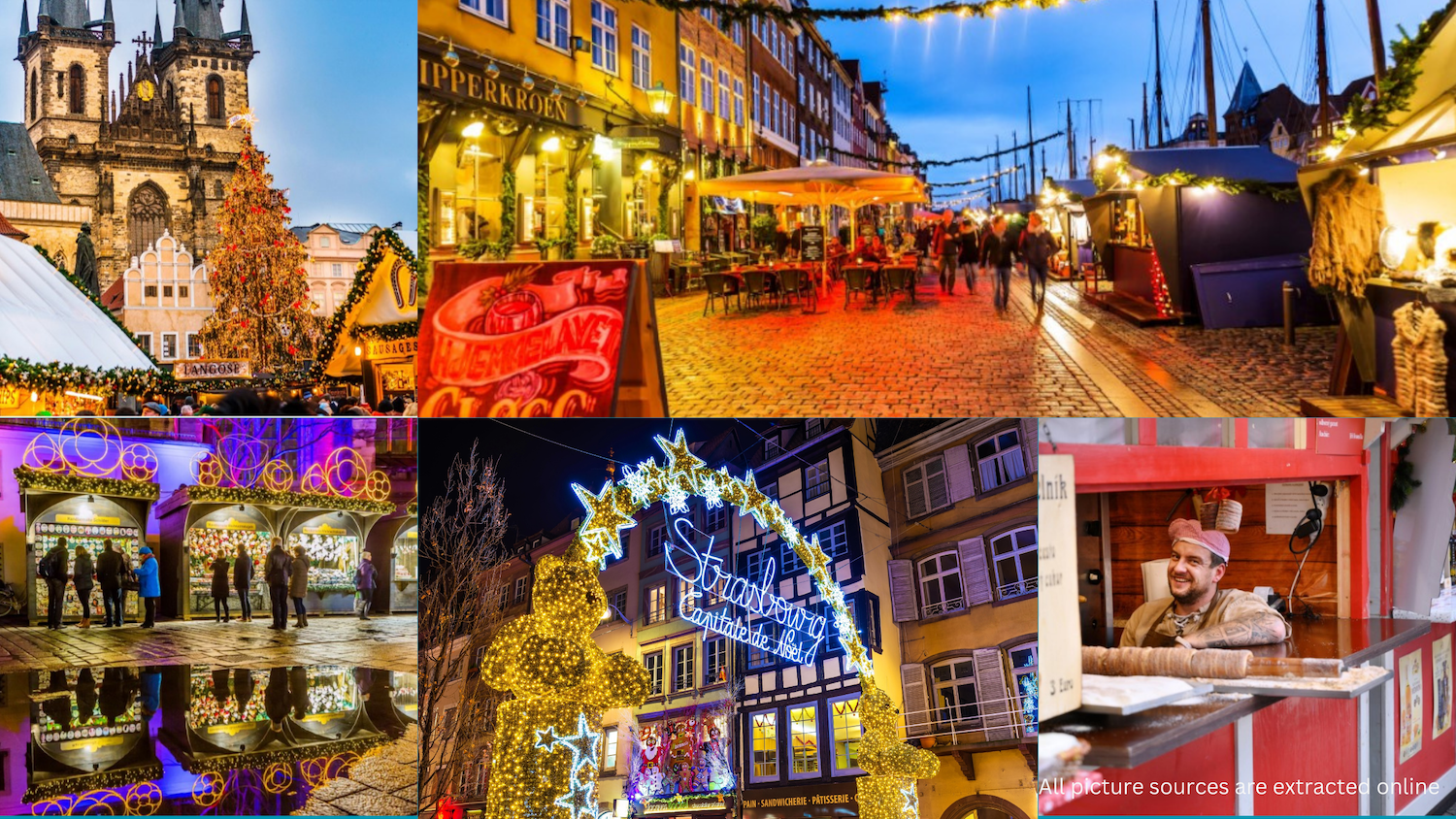
As winter descends upon Europe, the continent comes alive with the festive spirit of Christmas. One of the most cherished traditions during this season is the Christmas market, where locals and tourists alike gather to revel in the magic of the holidays. These markets, known for their twinkling lights, festive decorations, and the aroma of mulled wine and roasted chestnuts, are a quintessential part of the European yuletide experience.
Christmas markets, also referred to as Christkindlmarkt (Christ child market) in German-speaking regions, can be defined as seasonal markets that celebrate the Christmas season. These markets typically open in late November or early December and run until Christmas Eve or after the new year. They are characterised by stalls or booths adorned with festive decorations, offering a wide array of seasonal goods, crafts, and food items.
Like any market, there are both positive and negative aspects to consider regarding consumer experiences. In this article, I explore the effects of Christmas markets on consumer behavior, researching into the positive and negative dimensions. Additionally, I offer managerial recommendations to enhance and optimise these markets for a more enriching consumer experience.
Christmas market Forms and Locations
Christmas markets come in various forms, each reflecting the unique cultural identity of the region. Traditional wooden stalls line the streets and squares, creating a picturesque scene reminiscent of a winter wonderland. In larger cities, Christmas markets often sprawl across multiple locations, each with its own theme and atmosphere. Some of the Christmas market destinations can be Germany, France, Austria and Switzerland.
- German Christmas Markets: Germany is widely considered the birthplace of the Christmas market tradition. Cities like Nuremberg, Munich, and Cologne host some of the most renowned markets, featuring elaborate decorations, handmade crafts, and traditional German treats like bratwurst and stollen.
- French Marchés de Noël: In France, Christmas markets, or Marchés de Noël, are found in cities and towns across the country. Strasbourg, with its Christkindelsmärik, claims to be the oldest Christmas market in Europe. French markets showcase a blend of local craftsmanship, regional specialties, and a festive ambiance.
- Austrian and Swiss Markets: Austria and Switzerland boast charming markets set against stunning alpine backdrops. Cities like Vienna and Zurich transform into winter wonderlands, offering visitors a mix of cultural performances, handicrafts, and delectable treats.
Christmas Market Commonalities and Differences
While Christmas markets share common elements, such as the presence of seasonal goods and a festive atmosphere, each market bears the distinct imprint of its cultural heritage. To list a few, decoration, food
- Decorations and Ambiance: All Christmas markets are adorned with sparkling lights, festive decorations, and Christmas trees. The ambiance is enhanced by the sound of carolers, live music, and the joyful laughter of visitors.
- Culinary Delights: Culinary offerings are a highlight of Christmas markets. Traditional treats like mulled wine, gingerbread cookies, roasted chestnuts, and regional specialties are a common thread, but the specific flavours and dishes vary from country to country.
- Handcrafted Gifts: Handcrafted gifts and ornaments are a staple in European Christmas markets. Visitors can find unique, locally made items ranging from wooden toys and ornaments to intricate glassware and textiles.
- Cultural Traditions: Each market showcases local cultural traditions, whether through live performances, processions, or themed events. From the Krampus parades in Austria to the Santa Claus processions in the Netherlands, these events add a unique touch to the overall experience.
Positive & Negative Aspects of Customer Experience
A positive customer experience is often associated with visiting Christmas markets. However, there are expressions of concern regarding many European markets that have become less attractive and relevant.
Christmas markets offer consumers a unique platform to immerse themselves in the festive atmosphere associated with Christmas and the holiday’s spirit. The ambiance, created by decorations, festive lights, and seasonal music, enhances the overall experience, making it a memorable and joyful occasion. Consumers are enticed by the allure of exploring new destinations or enjoying a local experience through the unique offerings of each Christmas market. The opportunity to discover local vendors and artisans adds an element of authenticity, fostering a connection between consumers and the community.
The physical transformation of public spaces into Christmassy destinations contributes to a sense of wonder and excitement. Well-designed and themed decorations enhance the aesthetics, creating a visually pleasing environment that encourages consumers to stay and engage.
Christmas markets succeed in creating a sense of immediacy, allowing consumers to live in the present moment and savour the holiday experience. The festive atmosphere encourages spontaneous interactions, fostering positive emotions and memories, creating “here and now” moments. Consumers often engage in various activities, from sampling local cuisine to participating in games and entertainment. The diverse range of food, drinks, and activities contributes to a holistic and enjoyable consumer experience.
On the other hand, some Christmas markets may lose their charm by adopting a generic, formatted approach that fails to showcase local specialties. Consumers may be disappointed if the market lacks unique offerings that reflect the cultural identity of the region. The presence of the same brands and product vendors across different Christmas markets can create a sense of monotony. Consumers visiting multiple markets may feel they are experiencing a repetitive and uninspiring shopping environment. Christmas markets that resemble conventional markets with basic kiosks may fail to capture the essence of the Christmas spirit. The lack of creativity in market design can diminish the overall appeal and fail to create a distinct, festive atmosphere. The proliferation of Christmas markets without consideration for social spaces may lead to over-commercialisation. Consumers might perceive Christmas markets as franchised entities devoid of cultural authenticity, contributing to a loss of charm.

Final thoughts and Recommendations:
The positive and negative aspects of Christmas markets highlight the need for strategic management to optimise consumer experiences. To optimise the consumer experience at Christmas markets, several strategic recommendations can be implemented.
First and foremost, promoting local identity is crucial. Market organisers should encourage vendors to showcase local specialties, crafts, and traditions, thereby enhancing the market’s uniqueness. Collaboration with local artists and artisans is essential to infuse cultural elements into both the market’s design and offerings.
Secondly, diversifying vendor selection is paramount to prevent the homogeneity observed across different markets. Guidelines should be implemented to ensure a diverse range of vendors, with a priority given to local and small businesses, supporting the community, and providing consumers with a wider array of choices.
Innovative market design is the third key recommendation, involving investments in creative design that captures the essence of Christmas, creating a visually appealing and immersive experience. This can be achieved by incorporating interactive elements, themed sections, and engaging activities to enhance overall consumer enjoyment. Strategically placing markets in locations that promote social interaction and community engagement is the fourth recommendation. Careful consideration should be given to avoiding the over-saturation of areas with multiple Christmas markets to prevent over-commercialisation, ensuring each market retains its unique character.
Educating, and empowering vendors is crucial. By providing guidelines on maintaining cultural relevance and fostering a sense of pride and ownership among vendors, organisers can encourage active participation, contributing to the festive atmosphere and an overall positive consumer experience.
Finally, Christmas markets should prioritise the creation of inviting spaces that not only encourage visitors to linger but also provide a comfortable environment for socialising, shopping, indulging in culinary delights, or simply enjoying their time. While the transactional aspect is undeniably important, emphasising the social dimension can yield even more positive effects in terms of both customer satisfaction and overall business success. By fostering a warm and welcoming atmosphere that beckons people to stay, connect, and partake in the festive spirit, Christmas markets can elevate the overall experience, creating lasting memories and fostering a sense of community that extends beyond mere transactions.
Christmas markets play a significant role in shaping consumer experiences during the holiday season. By understanding and addressing both the positive and negative aspects, market organisers and local authorities can work collaboratively to create vibrant, culturally rich, and unforgettable Christmas market experiences that resonate with consumers and contribute to the joyous spirit of Christmas.





